Four veg-forward recipes from Hetty McKinnon's new cookbook Tenderheart
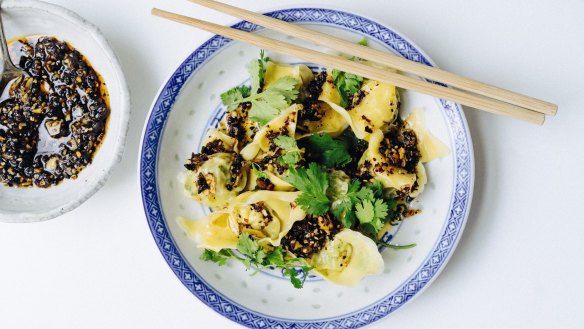
Vegetables are the heroes of Hetty Lui McKinnon's new collection of 180 recipes inspired by family, connection and the legacy of food. Each chapter of Tenderheart is devoted to one McKinnon's 22 favourite vegetables. Here are four recipes to try at home.
Broccoli wontons with umami crisp
Like dumplings, making wontons is a mindful ritual, an exercise of patience. Folding wontons would take up an entire afternoon for my mother, as she always made them in bulk, ready for freezing. With some planning, wontons are a wonderful last-minute meal. Broccoli once again flexes its versatility, providing bright-green notes, which make every mouthful a delight. The potato performs two vital functions: it provides body to the filling, while also binding the ingredients together. Here, I have served the wontons simply, blanketed in my umami crisp (recipe here), but you could also serve them in a broth.
INGREDIENTS
- 1 large potato (about 250g), peeled and diced
- 1 tbsp roasted sesame oil
- 1 brown onion, finely diced
- 1 small head of broccoli (about 250g), florets and stalk roughly chopped
- 1 garlic clove, finely chopped
- sea salt and white pepper
- 2 tsp white (shiro) miso
- 2 spring onions, finely sliced
- 45-50 square wonton wrappers
- handful of coriander leaves
- 3-4 tbsp umami crisp, chilli oil or chilli crisp
- toasted white sesame seeds, to serve
METHOD
- Bring a saucepan of salted water to the boil. Add the potato and cook for 8-10 minutes, until very tender. Drain and place in a bowl, then roughly mash with a fork.
- Heat a frying pan over medium heat. Add the sesame oil and onion and cook for 2-3 minutes, until softened. Add the broccoli and garlic and season with about ½ teaspoon of sea salt and ¼ teaspoon of white pepper. Cook for 5-7 minutes, until the broccoli is very tender. Remove from the heat and allow to cool. Transfer the mixture to a chopping board and finely chop until the broccoli is almost minced. Add the broccoli mixture to the potato, then add the miso and green onion. Mix well, then taste and season with more sea salt and white pepper, if needed.
- Fill a small bowl with water for wetting the edges of the wonton wrappers. Keep the wrappers covered with a damp tea towel or in their original packaging while you work, as they dry out quickly. Holding a wrapper in the palm of your hand, place a heaped teaspoon of the filling in the centre of the wrapper (don't overfill). Moisten the wrapper around the filling with a dab of water, then carefully fold one corner to the opposite corner to form a triangle, making sure you press the two sides of the wonton together tightly to enclose the filling and avoid any air pockets, which can make the wontons burst. Bring the two opposite corners together, dab one corner with water, then overlap them and press to seal. Repeat with the remaining wrappers and filling. At this point, you can freeze the wontons, or cook immediately.
- Bring a large saucepan of salted water to the boil. Add the wontons, a few at a time, and cook for 1-2 minutes. When the wontons float to the top, cook for another 20 seconds, until the skins are translucent. Remove immediately with a slotted spoon.
- To serve, scatter with coriander leaves, top with the umami crisp, chilli oil or chilli crisp and finish with sesame seeds.
Makes 45-50 wontons
NOTES
- For gluten-free: use gluten-free wonton wrappers
- Veganise: use vegan wonton wrappers
- Substitute: potato for drained firm tofu
- Vegetable swap: broccoli for spinach, kale
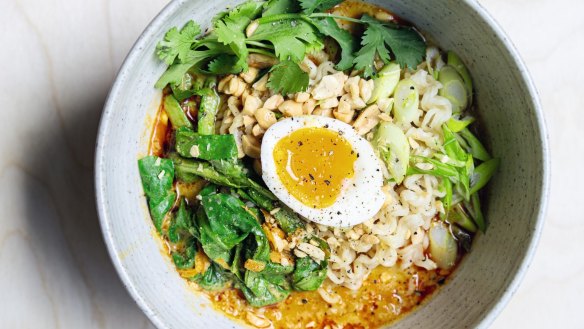
Carrot peanut satay ramen
The smell of satay takes me right back to childhood barbecues, when my mother would make satay chicken skewers, and the aroma of them cooking would waft over the entire neighbourhood. Here, I've used satay as the inspiration for this carrot-laden ramen. Peanut butter is the base of this broth, which is combined with grated carrots to provide heat and flavour, both thickening it up and adding a natural sweetness. You can blitz it up if you prefer a smooth broth, but I enjoy the occasional specks of carrot while I'm slurping the noodles.
INGREDIENTS
- 1-2 tbsp neutral oil
- 2 garlic cloves, finely chopped
- 4cm piece of ginger, peeled and finely chopped
- 3 carrots (about 250g), scrubbed and coarsely grated
- 1 tsp sea salt
- ½ tsp white sugar
- 200g (¾ cup) smooth peanut butter
- 1 litre (4 cups) vegan dashi vegetable stock
- 340g instant or ramen noodles
- handful of Asian greens, such as baby bok boy, tatsoi or choy sum, washed and patted dry, leaves picked
- handful of coriander leaves
- 2 spring onions, sliced
- ¼ cup roasted peanuts, chopped
- 4 soft-boiled eggs, halved (optional)
Seasonings
- 1 tbsp white sugar
- 2 tbsp soy sauce or tamari
- 1 tbsp rice vinegar
- 1 tbsp roasted sesame oil
- 1 tbsp doubanjiang or chilli oil
METHOD
- Heat a saucepan over medium-high heat. Drizzle with the oil and add the garlic and ginger. Cook for 1 minute until fragrant, then add the carrot, salt and sugar and cook for 3-5 minutes, until the carrot is softened and starting to caramelise. Add the peanut butter and dashi or vegetable stock and stir. Bring to the boil, then reduce the heat to low, cover and simmer for 5 minutes. This is a textured soup base – if you prefer it smooth, use a stick blender to puree.
- Meanwhile, bring a large saucepan of salted water to the boil. Add the noodles and cook according to the packet instructions. Drain.
- Lay out four bowls. In each bowl, add the following seasonings: 1 teaspoon of sugar, 2 teaspoons of soy sauce or tamari, 1 teaspoon of rice vinegar, 1 teaspoon of sesame oil and 1 teaspoon of doubanjiang or chilli oil. Whisk to combine.
- Add your greens to the broth, cook for 30 seconds, then immediately pour the broth and greens into the four bowls, on top of the seasonings, dividing it equally. Stir to combine. Divide the noodles between the bowls, top with the coriander leaves, green onion, peanuts and soft-boiled egg, if desired. Serve immediately.
Serves 4
NOTES
- Gluten-free: Use gluten-free soy sauce/tamari and chilli oil (not doubanjiang)
- Veganise: Substitute eggs with sliced tofu
- Vegetable swap: Asian greens for broccoli florets, kale
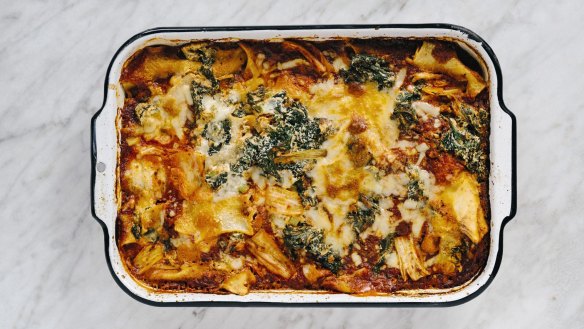
Torn lasagne with kale and kimchi
Nothing beats a well-constructed, meticulously composed lasagne, but for times when you just want the taste of this dish without the preparation time (and ingredients), this is a smart alternative. The dish is ready in three steps: wilt the kale; make a tomato sauce base; and combine the torn fresh lasagne sheets with cheese. There is no construction at all, you just bring the elements together in a deep dish and bake until golden. I often turn to kimchi to inject fast flavour and complexity to a dish, and here it does the job neatly. Gochugaru brings a sweet smokiness to the sauce. If you prefer, you could omit both the kimchi and gochugaru, which would give you more traditional lasagne flavours. I like to eat this with a green salad.
INGREDIENTS
- 1 bunch of kale (about 300g)
- extra virgin olive oil
- 1 garlic clove, finely chopped
- sea salt and black pepper
- 450g fresh lasagne sheets
- 500g (2 cups) ricotta
- 100g (1 cup) grated cheddar
- 200g (1 cup) regular or vegan kimchi
Smoky gochugaru sauce
- extra virgin olive oil
- 4 garlic cloves, finely chopped
- 2 tbsp gochugaru
- 2 tsp smoked paprika
- 2 tsp dried oregano
- 1 tsp white sugar sea salt
- 2 x 400g cans crushed tomatoes
METHOD
- Preheat the oven to 180C fan-forced (200C conventional).
- Separate the kale leaves from the stems. Tear the leaves and finely chop the stems.
- Heat a frying pan over medium-high heat, add a drizzle of olive oil, the kale stems and garlic, and saute for 1 minute. Add the kale leaves, season with sea salt and black pepper and cook for 3-4 minutes, until the kale is wilted but still bright green. Remove from the heat and set aside.
- To make the smoky gochugaru sauce, heat a large saucepan over medium heat. Add 1-2 tbsp of olive oil and the garlic and cook for 30 seconds until aromatic. Add the gochugaru, smoked paprika, oregano, sugar and about 1 teaspoon of sea salt, and stir to combine. Pour in the crushed tomatoes and 500ml (2 cups) of water (you can use the crushed tomato can by filling it about three-quarters full; this is also a great way of removing any leftover tomatoes and juices in the can) and stir. Cover with a lid and cook for 20 minutes, to allow the flavours to meld.
- Tear the lasagne sheets into smaller but still large-ish pieces – ideally around 5-10cm wide; they do not need to be uniform.
- Place the ricotta in a large mixing bowl, add 2 tablespoons of water and whisk to loosen it up. Add half the cheddar, 2 tablespoons of olive oil and season with sea salt and black pepper. Fold in the wilted kale and kale stems. Finally, add the kimchi and torn lasagne sheets and stir to combine.
- Pour the gochugaru sauce into a 30cm × 20cm (or thereabouts) baking dish. Add the cheese, kale and lasagne sheet mixture to the sauce and gently mix through. Top with the remaining cheddar and bake for 35-40 minutes, until bubbly and golden. Allow to sit for 10 minutes before serving.
Shortcut: Skip the smoky gochugaru sauce and use a store-bought tomato-based pasta sauce. You can add gochugaru and spices to the sauce or use it plain.
Serves 4
NOTES
- For gluten-free: use gluten-free lasagne sheets
- Veganise: use dairy-free ricotta and cheddar
- Substitute: fresh lasagne sheets with tortillas, lavash bread
- Vegetable swap: kale for cabbage, spinach, brussels sprouts
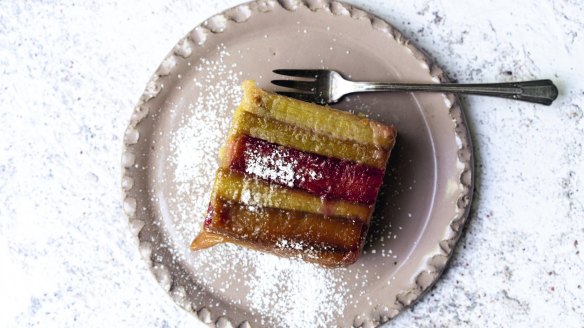
Upside-down rhubarb and ginger olive oil cake
Rhubarb perfectly captures the transience of time, the fickleness of the seasons. When this fugacious fruit makes its annual cameo during the spring, it means baking is imminent (though it can also be used in savoury dishes). Rhubarb is naturally tart, but sugar will bring relief and extract its jaunty fruitiness. Ginger is a natural foil to rhubarb's astringency, bringing a touch of heat and spice. In this classic upside-down cake, the rhubarb is lightly stewed in a ginger syrup – take care not to overcook as you want the rhubarb to hold its shape. I use both fresh and ground ginger in this recipe – they each bring slightly different characteristics: the former adds texture and a bright spicy hum, while the latter has a stronger, more emphatic, gingery kick.
INGREDIENTS
- 150g (¾ cup) brown sugar
- 2 eggs
- 150g (¾ cup) sour cream
- 180ml (¾ cup) extra virgin olive oil
- 1 tsp ground ginger
- 2.5cm piece of ginger (about 20g), peeled and grated
- ½ tsp sea salt
- 1 tsp vanilla paste or extract
- 185g (1¼ cups) plain flour
- 1 tsp baking powder
- ½ tsp bicarbonate of soda
- icing sugar, to serve (optional)
Stewed rhubarb
- 3 tbsp salted butter
- 75g (⅓ cup) white sugar
- 1 tsp vanilla paste or extract
- 2.5cm piece of ginger (about 20g), peeled and grated
- 300g rhubarb, trimmed and cut into 5cm strips
METHOD
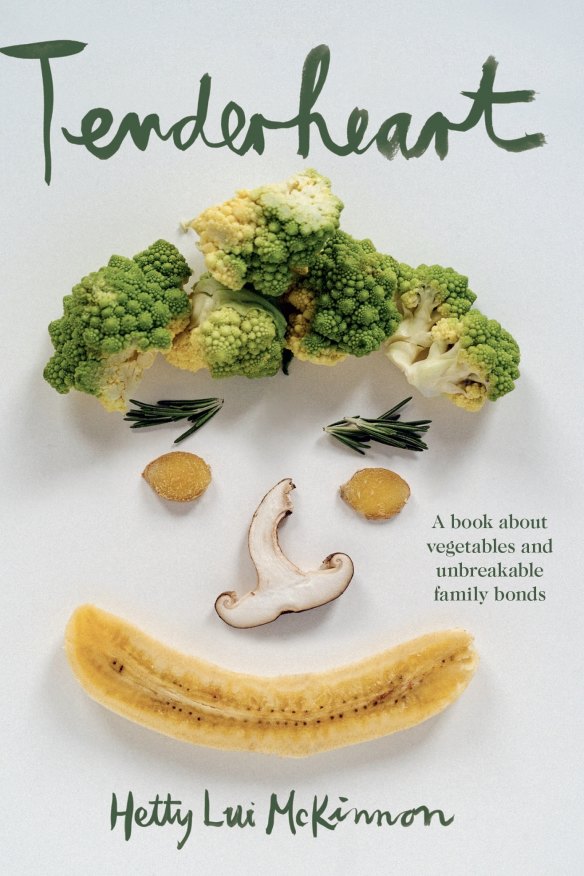
- Preheat the oven to 160C fan-forced (180C conventional). Grease a 20cm square cake tin with non-stick oil spray and line with baking paper.
- To make the stewed rhubarb, heat a saucepan over medium heat and melt the butter. Add the sugar, vanilla and ginger and stir together. Add the rhubarb and stir to coat well. Reduce the heat to medium-low and cook for 3-4 minutes, until the rhubarb has softened slightly but is still holding its shape (we don't want mush). Remove from the heat and pour the rhubarb (along with any syrup) into the prepared tin. Carefully arrange the rhubarb into neat rows, or in any pattern you like.
- In a large mixing bowl, add the brown sugar, eggs, sour cream, olive oil, ground ginger, grated ginger, sea salt and vanilla and whisk together until well combined. Add the flour, baking powder and bicarbonate of soda and whisk until just combined.
- Pour the batter over the rhubarb, smoothing it evenly so that all the rhubarb is covered completely. Place on the middle shelf of the oven and bake for 30-35 minutes, until an inserted skewer comes out clean. Remove from the oven and cool for 10 minutes, then very carefully invert the cake onto a plate or board. Dust with icing sugar, if desired, and serve. This cake is best eaten on the day it is baked, but it can be kept in an airtight container in the fridge for up to 3 days.
Serves 8
NOTES
- For gluten-free: use cup-for-cup gluten-free plain flour
This is an edited extract from Tenderheart by Hetty Lui McKinnon, published by Plum, RRP $59.99. Photography by Hetty Lui McKinnon and Shirley Cai. Buy now
Appears in these collections
From our partners
Original URL: https://www.smh.com.au/goodfood/four-vegforward-recipes-from-hetty-mckinnons-new-cookbook-tenderheart-20220819-h25tt6.html

